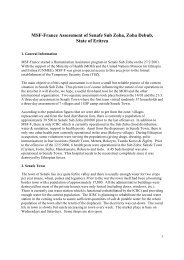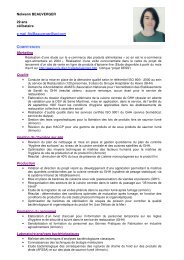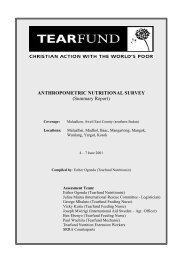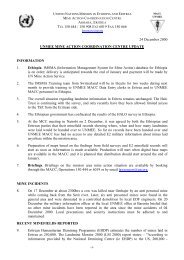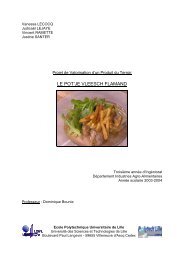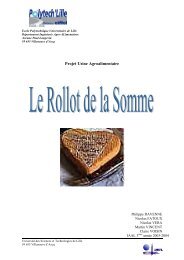Sitrep: Wajir Emergency 28/05 –10/06/2001 - PFEDA / Page d ...
Sitrep: Wajir Emergency 28/05 –10/06/2001 - PFEDA / Page d ...
Sitrep: Wajir Emergency 28/05 –10/06/2001 - PFEDA / Page d ...
Create successful ePaper yourself
Turn your PDF publications into a flip-book with our unique Google optimized e-Paper software.
<strong>Sitrep</strong>: <strong>Wajir</strong> <strong>Emergency</strong> <strong>28</strong>/<strong>05</strong> <strong>–10</strong>/<strong>06</strong>/<strong>2001</strong><br />
Latest<br />
Developments<br />
including security<br />
situation<br />
Save the Children Situation Report:<br />
• General Situation and Security<br />
Not much change on the weather front occurred; <strong>Wajir</strong> town and<br />
environs have been enjoying some how cloudy cool days and cooler<br />
nights and the vegetation seems to have lasted a bit longer. Reports<br />
from the SFP outreach team (W and N of district) indicate that milk is<br />
in plenty supply and that both fauna and flora are flourishing.<br />
The security situation in the North (as reported in the last <strong>Sitrep</strong>)<br />
seems to have been contained. So far, both the Garres and Ajuran are<br />
living peacefully. However, the incident in which a Garre was killed few<br />
weeks ago in Kunkum is building up tension between the Garres and<br />
the Boraan in the neighbouring district of Moyale.<br />
Over the weeks, two persons were killed as a result of eviction of a<br />
small Somali clan allied to the Ajuran tribe from the West of <strong>Wajir</strong>.<br />
They were attacked between Adibohol and Arbajahan villages whilst<br />
returning to their traditional grazing area near Korondille. The<br />
emigrates who are originally residents of <strong>Wajir</strong> West had moved to<br />
Isiolo district five years ago because of persistent drought in <strong>Wajir</strong><br />
district. Recently, they have been directed by the provincial<br />
administration to move out of Isiolo district after a long-standing feud<br />
between Somali pastoralists from <strong>Wajir</strong> district and the Boraans<br />
tribesman of Isiolo district in which many lost their lives. Much of the<br />
trouble around the two districts is of political nature and expected to<br />
continue probably towards the forthcoming general election.<br />
The incident reported earlier between Gabra tribesmen from bordering<br />
Marsabit district and Jibrail sub-clan of Degodia near Arbajahan is still<br />
simmering up. The <strong>Wajir</strong> District Commissioner recently made a public<br />
baraza in Arbajahan to quill the tension after some 109 camels raided<br />
by the Gabras were returned from Marsabit to their owners in<br />
Arbajahan. A small contingent of Kenya Army together with combined<br />
regular and administration police are now stationed near Arbajahan to<br />
allay fears of revenge attack.<br />
The use of armed escorts to Arbajahan area is recommended<br />
nowadays, a measure to be continued until further notice.<br />
• Cholera outbreak<br />
The cholera outbreak within <strong>Wajir</strong> town and surroundings is persisting.<br />
Sporadic cases are reported from as far as 35 Km from <strong>Wajir</strong> town to<br />
the West of the district.<br />
While the number of cases admitted at CTC is 2-3 daily with no deaths<br />
reported during this reporting period, the co-ordinating team at the<br />
district level under the chairmanship of the MOH is aware that the<br />
1
<strong>Sitrep</strong>: <strong>Wajir</strong> <strong>Emergency</strong> <strong>28</strong>/<strong>05</strong> <strong>–10</strong>/<strong>06</strong>/<strong>2001</strong><br />
Save the Children Situation Report:<br />
outbreak is far from over. Three deaths have been reported from the<br />
bullas around town and recently 1 death was reported from right in the<br />
town centre. All those who died had diarrhoea and vomiting (D&V)<br />
suggestive of cholera.<br />
The UNICEF Somalia team has greatly assisted the Ministry of Health<br />
especially in the field activities, which include social mobilisation using<br />
a Cholera video show translated into Somali language inside <strong>Wajir</strong><br />
town and in some villages to the west.<br />
A training of 200 selected Community leaders from <strong>Wajir</strong> town and its<br />
vicinity on social mobilisation for cholera control is on going. The<br />
training is organised by the MoH public health office and sponsered by<br />
SC/UNICEF. There are 4 training sessions of 2 days, each for a group<br />
of 50 participants. The first two groups from Bulla Wagberi, Halane,<br />
Jogoo, Got-ade and Makoror have completed their training and are<br />
actively organising themselves to combat the cholera by conducting<br />
general cleanness and health talks in their communities.<br />
The District Cholera Co-ordinating Team meets every other day to<br />
discuss and review the epidemiological data generated by the<br />
surveillance team and reports from the CTC. The efficiency of the<br />
team however is greatly affected by the laxity and apathy exhibited by<br />
the District Public Health Officer. Mr. Fankey who should be the head<br />
of the surveillance team does very little in support of the decisions by<br />
the co-ordinating team.<br />
Suggestions by the Provincial Medical Officer (North Eastern<br />
Province) to try and use slow release chlorinating methods for the<br />
wells around <strong>Wajir</strong> was termed as ‘foreign ideology’ by the above<br />
Officer and thus was never tried at all. The advice given by any<br />
organisation represented (UNICEF, SC(UK), MoH members) at the coordinating<br />
committee is totally ignored. The departure of Dr. Mukhtar<br />
(the DMO) for a meeting in Garissa where he decided to take a leave<br />
until July has left the MoH with very poor leadership and dominated by<br />
a controversial person very much unwilling to co-operate.<br />
The ineffectiveness of the surveillance team due to poor leadership is<br />
a major contributing factor to the slow rate at which this cholera<br />
menace is being contained.<br />
A total of 24 ORS Centres have been established around the bullas of<br />
<strong>Wajir</strong>. The UNICEF Somalia teams who assisted in the establishment<br />
of the ORS Centres have met a lot of resistance from the surveillance<br />
team in the process. On the other hand, the communities at the<br />
various bullas are very receptive to the team and social mobilisation is<br />
progressing very well with community support.<br />
There is still no proper mechanism of reporting deaths at the bullas,<br />
due to a lack of regular reporting from the surveillance teams.<br />
Unverified information received indicates that the death toll is much<br />
higher than the deaths recorded in the CTC. The matter has been<br />
raised at the Co-ordinating meeting by SC (UK). Consequently the<br />
surveillance team leader has been changed and the CO from Garissa<br />
has been tasked with the responsibility of leading the surveillance<br />
2
<strong>Sitrep</strong>: <strong>Wajir</strong> <strong>Emergency</strong> <strong>28</strong>/<strong>05</strong> <strong>–10</strong>/<strong>06</strong>/<strong>2001</strong><br />
team.<br />
Save the Children Situation Report:<br />
No new cases are reported from Tarbaj since the last reporting period.<br />
This does not however mean that there are no cases. Staff at the local<br />
health facility manages the few cases that are reported. The health<br />
facility has been supplied with adequate ringers lactate, doxycycline<br />
caps and erythromycin tabs & syrup.<br />
The cumulative numbers of patients with D&V who have gone through<br />
the Cholera Treatment Centre since the month of April are 207. The<br />
deaths toll still stand at 11 giving a Case Fatality Rate of 5.3%. Given<br />
the poor information on fatalities outside the CTC, this death does not<br />
represent the total number of cholera deaths.<br />
The management of cases at CTC still needs improvement. Despite<br />
the very few cases at the ward, the staff does not seem to understand<br />
the need for the continuous dehydration for patients who are stable<br />
using ORS. Many times, we find patients sitting idle or drinking bottled<br />
water brought in by relatives. This has been pointed out at the<br />
meetings though not much positive change has been observed. The<br />
SC team on the routine visit to the CTC always makes a point of<br />
discussing the above issues with the nurses concerned.<br />
A child of one year old was admitted at the CTC on May 21 st and died<br />
on the 25th. The child initially presented D&V with chest problems<br />
suggestive of Pneumonia. The child however was kept at the CTC<br />
even after the D&V had ceased, instead of being transferred to the<br />
paediatric ward for further management of the chest complications.<br />
The above example illustrates the conditions that exist at the CTC<br />
despite the good number of staff attached to the CTC. The main<br />
problem is poor supervision by the senior-nursing Officer who should<br />
be on top of everything but seems to be having problems and/or rather<br />
feels sidelined by the DHMT.<br />
The communication between the nurses and the Clinical Officers who<br />
refer patients from MCH to ward 4 (CTC) seems to be non-existent.<br />
Inter-ward communication is equally weak. Cases with confirmed<br />
typhoid have been found to be admitted at the CTC, which beats the<br />
whole purpose of the CTC as the same patients with typhoid could<br />
easily contract cholera from the CTC.<br />
Infection control at CTC has improved since the deployment of one SC<br />
staff from the former TFC to be in charge of sanitation and infection<br />
control together with an Officer from Ministry of Health.<br />
Though MoH at provincial level sent to <strong>Wajir</strong> 9 MoH staff (2 CO, 4<br />
nurses and 2 PHO) to support the cholera control efforts in <strong>Wajir</strong>,<br />
these people were under-utilised and even left out of most of the<br />
arrangements made. This situation lead to frustration of some<br />
members who eventually decided to leave <strong>Wajir</strong> even without the<br />
knowledge of their team leader from Garissa who also left on the 8 th of<br />
June.<br />
3
<strong>Sitrep</strong>: <strong>Wajir</strong> <strong>Emergency</strong> <strong>28</strong>/<strong>05</strong> <strong>–10</strong>/<strong>06</strong>/<strong>2001</strong><br />
Impact on<br />
Children<br />
Constraints<br />
on<br />
Humanitarian<br />
Action<br />
Save the Children<br />
Response<br />
Save the Children Situation Report:<br />
The cholera outbreak trend from the data available indicates that more<br />
adults >15yrs are getting affected unlike before when there were more<br />
children.<br />
• Other<br />
Helena Eversole, the deputy UNICEF Country Rep. visited <strong>Wajir</strong> for a<br />
day to check on the cholera response and to arrange for local<br />
participation in the upcoming UNICEF/GoK Mid-term review of the<br />
country Master Plans of Operations for Kenya. This MTR is scheduled<br />
in <strong>Wajir</strong> from 10-17 June, conducted by an inter-sectoral team from<br />
Nairobi. She also hosted a dinner in the SC compound where DC,<br />
OoP Rep. and other government persons were invited as well as<br />
NGOs based in <strong>Wajir</strong>.<br />
The exhibited poor MoH/DHMT commitment and lack of good<br />
leadership has a negative impact on the livelihood of many vulnerable<br />
women and children in <strong>Wajir</strong> district. This is clearly portrayed by the<br />
persisting cholera epidemic in spite of financial resources and<br />
technical assistance availed by the humanitarian community (UNICEF,<br />
SC(UK) and other donors like OFDA).<br />
The constrained relationship with a member of the DHMT (see higher)<br />
and the continued fight around issues of accountability with the entire<br />
DHMT have compromised the efforts to rapidly eradicate the cholera<br />
outbreak. The suggested approach to this could be to advocate for<br />
internal changes within the DHMT or a stronger leadership to bring<br />
things under control. The alternative approach could be moving into<br />
more community involvement and using them as counterparts with the<br />
MoH as the technical advisor to the community. While this issue will be<br />
discussed during the next SC project review meeting, the current<br />
approach remains to exhaust all possible diplomatic ways to defuse<br />
the tension and to ensure accountability.<br />
• Health<br />
The SC(UK) response during the reporting period has been in the area<br />
of cholera containment. Along that line SC/UNICEF sponsored a<br />
training of 200 influential community leaders. They will mobilise their<br />
community to contain the cholera outbreak through activities like water<br />
chlorinating, improving of personal hygiene, early detection and<br />
referral of suspected cases and reporting of deaths attributed to<br />
diarrhoea and vomiting.<br />
Also as part of the response to control the cholera epidemic, SC<br />
continues to provide logistical/medical supplies and allowances to the<br />
MoH team conducting the surveillance in villages around <strong>Wajir</strong>.<br />
4
<strong>Sitrep</strong>: <strong>Wajir</strong> <strong>Emergency</strong> <strong>28</strong>/<strong>05</strong> <strong>–10</strong>/<strong>06</strong>/<strong>2001</strong><br />
Save the Children Situation Report:<br />
• Food and Nutrition.<br />
The two nurses that were recently transferred from the (closed) TFC to<br />
the SFP team have been working very well, providing treatment and<br />
immunisation to the children in the targeted Supplementary Feeding<br />
Programme. Caution has to be exerted however to avoid that their<br />
presence at the SFP distribution sites displaces the MoH health staff<br />
currently working at the health centres and outposts. It has been<br />
emphasised to the SC nurses that they are there to complement and<br />
assist the MoH health staff, and not serve as a substitute. A mass<br />
immunisation of the village of Adhibohol (located between Hadado and<br />
Arbajahan, and home to 15 beneficiaries of the SFP), was proposed<br />
by the SC(UK) SFP staff recently. This was agreed upon, provided this<br />
is done in conjunction with MoH health staff from Hadado. This<br />
relationship needs to be monitored with due attention.<br />
Another SFP issue that needs to be addressed is the perception of the<br />
community (mothers, leaders, elders… ) of the SFP. It has long been<br />
felt by many in SC (UK) that there is little or no sense of community<br />
ownership of the SFP, but that it is rather seen as an external entity or<br />
an employment opportunity for the community. This is apparent when<br />
storage and off-loading fees are demanded by community leaders.<br />
Francis Battal (Project Manager) and Abdi Araru (Liaison Officer) have<br />
scheduled a trip to Arbajahan to sort this out with the community there.<br />
Distribution:<br />
West<br />
All sites experience decreasing enrolment numbers due to high levels<br />
of discharges and defaulters. In Hadado and Arbajahan, there was a<br />
sharp increase in the number of defaulters, though there were also<br />
many children in the programme discharged. It is suspected that<br />
migration of families towards better grazing land is the motivation for<br />
defaulting in this area.<br />
The proportion of the enrolled children gaining weight varied<br />
considerably from site to site, ranging from 56 % to 82 %. The<br />
proportion of the enrolled children losing weight ranged from 14 to 23<br />
%. The coverage of measles immunisation, and distribution of<br />
mebendazole and vitamin A has greatly improved in the west. Among<br />
the four sites, the proportion of the enrolled children immunised with<br />
measles ranges from 88 % to 96 %, while the proportion of children<br />
who have received mebendazole and vitamin A range from 93 % to<br />
100 %.<br />
Below is a summary of the current enrolment in the West:<br />
Location Number Under Fives Total Beneficiaries<br />
Hadado 19 67<br />
Arbajahan 65 151<br />
Griftu 34 98<br />
Eldas 55 166<br />
Total in West 173 482<br />
North<br />
The week of 4 June was the second distribution week under a new<br />
5
<strong>Sitrep</strong>: <strong>Wajir</strong> <strong>Emergency</strong> <strong>28</strong>/<strong>05</strong> <strong>–10</strong>/<strong>06</strong>/<strong>2001</strong><br />
Save the Children Situation Report:<br />
SFP supervisor, and no major issues or problems were reported. This<br />
supervisor, however, only oversees the Buna, Korondile, and Ajawa<br />
distributions, while the Bute distribution is under an additional<br />
supervisor.<br />
There were a substantial number of discharges in Buna and Korondile,<br />
while also some children defaulted. The number of new admissions<br />
remains low. These statistics are an indication of an improved<br />
nutritional situation.<br />
Location Number Under Fives Total Beneficiaries<br />
Korondile 30 126<br />
Ajawa 12 55<br />
Buna 58 160<br />
Bute 91 190<br />
(Bute figures for this week not available yet; figures used in this table<br />
are of previous <strong>Sitrep</strong>)<br />
Total North 161 531<br />
Central<br />
The enrolment has remained quite stable in Makaror, with 43 new<br />
admissions, 38 discharges, 1 death, and 4 defaulters. Thus, there was<br />
no net gain in the number of children in the programme. Enrolment in<br />
Wagberi, however, decreased considerably, with 79 children<br />
discharged from the programme and 6 children defaulting.<br />
Medical inputs continue from both the SC (UK) nurse and the AMA<br />
nurse. There is the continued issue, however, of the risk of becoming<br />
a parallel system in this setting. The search continues for a viable<br />
solution to this: Will providing medical services at the distribution site<br />
replace the presence of the district hospital – the same system that SC<br />
(UK) is trying to build its capacity? Given drug shortages, prohibitive<br />
costs, and long distances associated with the hospital, won’t the<br />
presence of such medical services at the distribution undermine the<br />
ability of the hospital to deliver adequate services?<br />
Location Number Under Fives Total Beneficiaries<br />
Makaror 61 1<strong>28</strong><br />
Wagberi 46 121<br />
Total Central 107 249<br />
• Other<br />
Francis Battal joined the <strong>Wajir</strong> team as the new Project Manager on<br />
May 26 th , replacing Kevin O’Kane.<br />
6




